

Dappled willow (Salix integra) is a surprising little fellow with flamingo-like foliage.
Key facts to remember
Name – Salix integra
Family – Salicaceae
Type – Shrub
Height – 3 to 9 feet (1 to 3 m)
Foliage – deciduous
Exposure: full sun – Soil: cool – Flowering: March
Best is to plant in Fall to promote root development before winter, thus ensure optimal recovery from transplant shock. If potted or in containers, you can plant in spring without any risk.
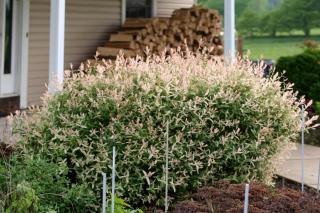 Salix integra fears excessive sun and places that are scorching in Summer.
Salix integra fears excessive sun and places that are scorching in Summer.Watering regularly over the first year after planting is important, and if you’re growing pink flamingo salix in pots you’ll have to water diligently during its entire life. Salix integra can resist the cold very well, down to 5°F (-15° Celsius), which makes it a very hardy shrub.
Taking cuttings is the easiest and fastest method to propagate your dappled willow.
 Dappled willow is a shrub that doesn’t require much care, especially when it’s properly settled in.
Dappled willow is a shrub that doesn’t require much care, especially when it’s properly settled in.
Among the diseases and parasites that infect this Salix integra willow, note that aphids are quite common, and there’s a slew of fungal diseases, too. If well fed, watered, with proper soil, your pink-leaved willow will have all it needs to fend these diseases and insects off on its own.
Most often, since the original plant is rather vulnerable to disease, the cultivar is grafted on a rootstock from another type of willow. Typically, goat willow (Salix caprea) rootstock will resist disease well, and the tree remains dwarfish and slow-growing.
It is an easy-to-control shrub that will follow the shapes you trim it into. It’s not very common to use Salix integra in a hedge, but the result is simply stunning.
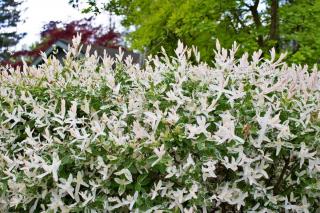 As part of a freestyle hedge, it will add brilliant colors for weeks after the trimming! As a hedge, this lovely willow will truly beautify your neighborhood.
As part of a freestyle hedge, it will add brilliant colors for weeks after the trimming! As a hedge, this lovely willow will truly beautify your neighborhood.
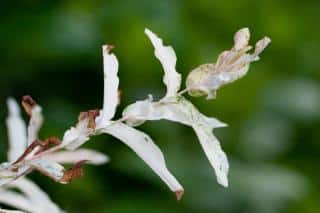 Being a willow, this tree needs lots of water.
Being a willow, this tree needs lots of water.
It’s important to water often, especially when the weather is hot and dry.
Soil should not be too soggy, though, or fungal diseases might develop.
Check that your willow isn’t caught in regular crosswinds, such as around the corner of a building. Hot air on warm days, heated by sun along walls, will course through your flamingo willow and dry exposed portions out.
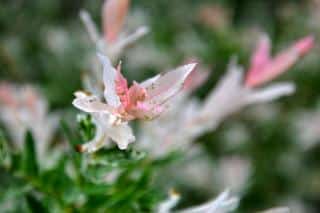 A beautiful shrub, Salix integra can bear leaves of beautiful colors from Spring to Fall. Selected by horticulturists, it also provides nice blooming in Spring: cute catkins that look like soft downy buds. What many find most appealing is its white and pink mottled foliage that appears in Spring, and the fact that it keeps a tight bearing and shape over the whole year.
A beautiful shrub, Salix integra can bear leaves of beautiful colors from Spring to Fall. Selected by horticulturists, it also provides nice blooming in Spring: cute catkins that look like soft downy buds. What many find most appealing is its white and pink mottled foliage that appears in Spring, and the fact that it keeps a tight bearing and shape over the whole year.
All Salix integra varieties are part of same family as their much taller cousin, the weeping willow.
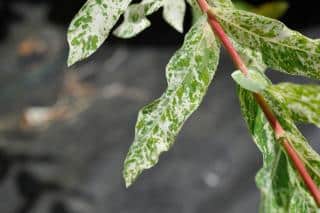 The most common and well-known variety is ‘Hakuro-nishiki’ willow. It is native to Japan, which explains one of this tree’s common names: Japanese dappled willow.
The most common and well-known variety is ‘Hakuro-nishiki’ willow. It is native to Japan, which explains one of this tree’s common names: Japanese dappled willow.
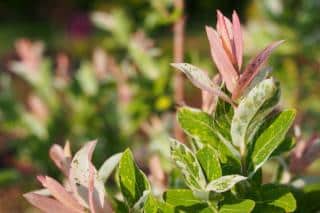 A newcomer is the ‘Flamingo’ Salix cultivar (patent #17,490). It is also very elegant and is cared for in the same manner. Leaves are a richer, pinker hue when they first unfurl.
A newcomer is the ‘Flamingo’ Salix cultivar (patent #17,490). It is also very elegant and is cared for in the same manner. Leaves are a richer, pinker hue when they first unfurl.
All these varieties excel as standalones, both in containers and in the garden, and they’ll do well in hedges, too.
To keep the soil moist and cool, make sure to spread mulch at the foot of the tree. Be careful when planting it against a wall: the heat reflected off the wall might dry the delicate leaves out. Similarly, avoid windy locations.